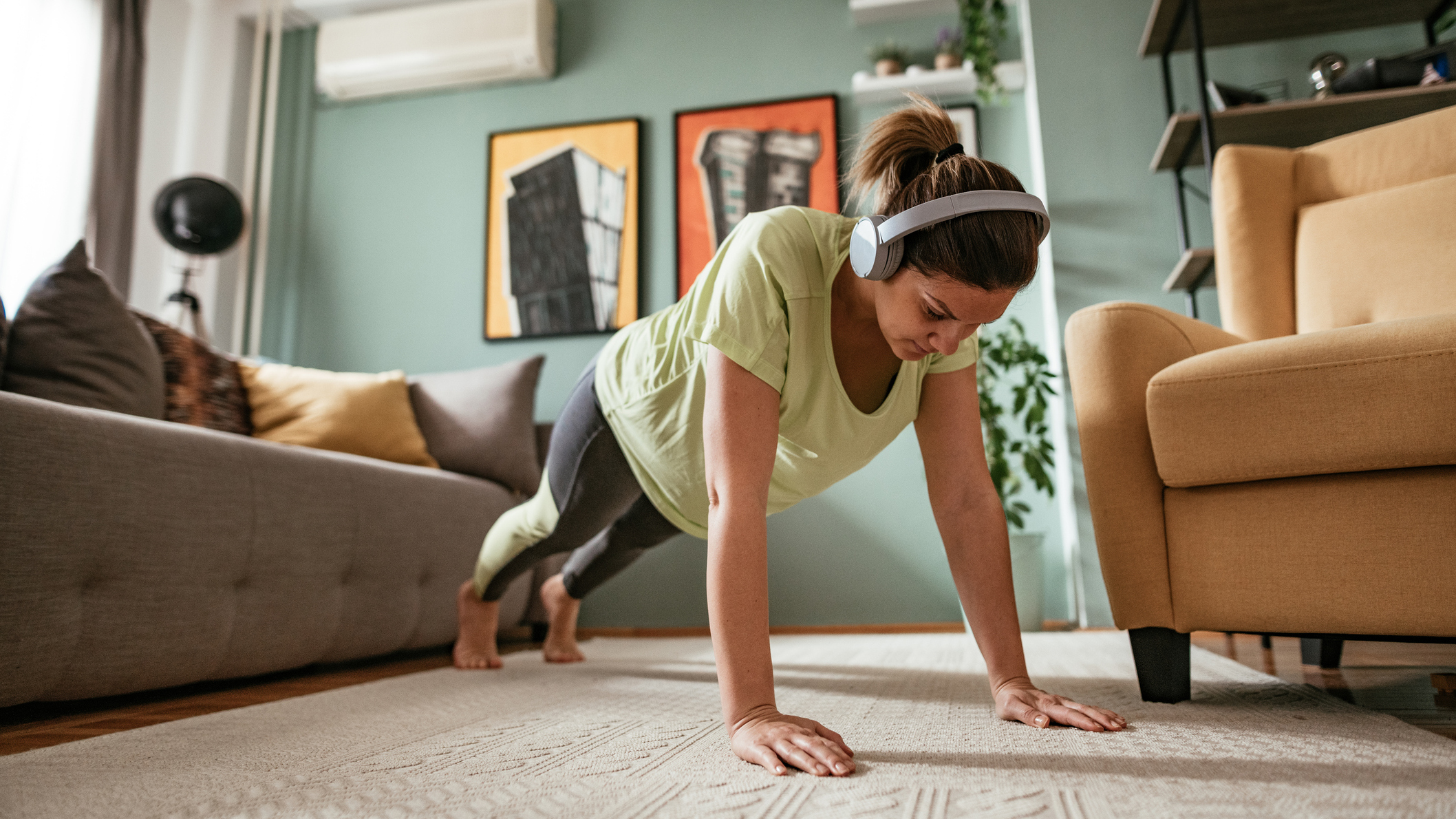
There’s no doubt that lifting weights can help you grow stronger, bigger shoulders. Barbell overhead presses and dumbbell raises feature in almost all the best shoulder workouts you’ll find on the web (including Coach’s). But if you’re new to lifting weights, or returning to exercise, these moves may seem difficult and intimidating.
The good news is that you don’t have to invest in a gym membership or buy a pair of adjustable dumbbells to start training your shoulders. With these simple beginner shoulder workouts, all you need is your own bodyweight or a low-cost resistance band.
It’s not just that this makes shoulder training more accessible. It’s a good idea to avoid weights when you first start performing shoulder exercises. Shoulders are among the most complex and mobile joints in the human body, and this makes them highly vulnerable to strains and injuries. If you’re just starting to train your upper body, there is a good chance your shoulders may lack a certain degree of strength and mobility.
Building up to dumbbell shoulder workouts with the routines below is one way to minimize your risk of injury. Another is to make a habit of beginning your session with a thorough warm-up and finishing with shoulder stretches. Finally, it’s imperative to listen to your body. If you’re struggling to complete a particular exercise, it’s best to stop and focus on developing your shoulder mobility instead.
Ready to get started? Below we’ve detailed a comprehensive shoulder warm-up routine, followed by a five-move bodyweight shoulder workout and a five-move resistance band shoulder workout to choose between.
Get Set With This Shoulder Mobility Warm-up
Before you start your workout, it’s essential that you warm up. This simple five-move routine will improve your joint mobility and boost the blood flow to your muscles. Focus on slowly increasing your range of movement, and taking deep breaths in and out. As you progress to shoulder workouts with weights, use this shoulder warm-up.
1 Cat-cow stretch
Sets 1 Reps 15
Get the Coach Newsletter
Sign up for workout ideas, training advice, reviews of the latest gear and more.
Start on all fours, with your wrists directly below your shoulders and your knees directly below your hips. First, get into the “cow” position by bringing your head up, dropping your chest and lifting your tailbone. Inhale deeply and squeeze your shoulder blades together. Pause for two seconds, then assume the “cat” position by tucking your chin into your chest, lowering your tailbone and rounding your back. Exhale as you pause for a couple of seconds, then slowly return to the starting position.
2 Child’s pose to cobra
Sets 1 Reps 15
On all fours with your knees wider than hip-width apart, sit your bum back toward your heels, extend your arms in front of you and lower your chest. This is child’s pose. From here, shift your body forward, straighten your arms and press your hips into the floor. Arch your back and turn your face upward to feel the stretch down the front of your body. Maintain this cobra position for a couple of seconds, then slowly return to child’s pose.
3 Shoulder lateral swing
Sets 1 Reps 15
Stand with your feet shoulder-width apart and arms by your sides. Raise your arms out to the sides so they’re parallel with the floor. Keeping your arms straight, cross them in front of you, and then dynamically bring them back to the starting position. Keep your back straight and engage your core muscles to avoid swaying side to side.
4 Standing straight-arm circles
Sets 1 Reps 30
Stand with your feet shoulder-width apart and arms by your sides. Raise your arms out to the sides so they’re parallel with the floor. Engage your core and, with a straight back throughout, begin to move your arms in small circles. As your joints warm up, gradually progress to larger circles. Don’t sway, tilt to the sides or tense up your neck.
5 Shoulder corkscrew
Sets 1 Reps 30
Stand with your feet shoulder-width apart and arms by your sides. Raise your arms out to the sides so they’re parallel with the floor and your thumbs are pointing up. Keeping your arms straight, rotate your arms so your thumb points forward and then to the floor. Slowly return to the start. Drive the movement from your shoulders and keep your core engaged throughout the movement.
Bodyweight Beginner Shoulder Workout
Developing your ability to perform functional movement patterns is the first step to increasing your strength and mobility, with your shoulders and every other body part. Compound bodyweight movements allow you to train your shoulders alongside other muscle groups, such as your back and chest. This approach will help you to avoid muscular imbalances, stabilize your shoulder joints and increase your overall body awareness.
If any exercise feels too easy, either increase the number of sets or reps, or slow down the tempo of the movement to put the muscles under tension for longer. Complete two to three sets of each exercise and eight to 12 repetitions per set. Take at least 15 seconds of rest between sets to catch your breath.
1 Incline push-up
Sets 2-3 Reps 8-12 Rest 15sec
Place your hands shoulder-width apart on an elevated surface, such as a bench or your sofa. The lower the object, the more difficult the movement. Keeping your hands directly below your shoulders, take a few steps back until your body forms a straight line from heels to head. Relax your neck, brace your core, then bend your elbows to lower your chest toward your hands. Press your hands away to return to the starting position. Don’t allow your elbows to flare out beyond a 45° angle from your body.
2 Mountain climber
Sets 2-3 Reps 8-12 Rest 15sec
Get on all fours, with your hands directly below your shoulders, then raise your knees off the floor until your body forms a straight line from heels to head. Engage your core and, keeping your hips level, drive one knee toward your chest, then return it to the start position. Repeat the movement on the other leg. That’s one repetition. Once you get into the rhythm, increase your pace until it feels like you’re running on the spot. If you’re struggling to count reps, work for 10-20 seconds.
3 Plank to downward dog
Sets 2-3 Reps 8-12 Rest 15sec
Begin on your hands and toes, with your hands directly below your shoulders. Your body should form a straight line from heels to head. Brace your core and relax your neck, then lift your hips high to assume an inverted V-shaped pose, pressing your shoulders away from your ears. Slowly return to the starting position. If you struggle to maintain the V-shape, place your hands on a bench or step to reduce the pressure on your shoulders.
4 Bent-over Y raise
Sets 2-3 Reps 8-12 Rest 15sec
Stand with your feet shoulder-width apart. Keeping your knees slightly bent, back straight and core engaged, hinge forward from your hips until your body is at a 45° angle with the floor. Raise your arms up and out so that your torso and arms form the letter Y. Squeeze your shoulder blades together to lift your arms slightly higher, hold this position for a couple of seconds, then lower your arms and repeat.
5 Superman row
Sets 2-3 Reps 8-12 Rest 15sec
Lie face down with your arms extended in front of you. Brace your core, glutes and thighs, and lift your arms, chest, and legs off the floor, while maintaining a neutral neck position. Pull your elbows back toward your ribs and squeeze your shoulder blades hard for a couple of seconds, then extend your arms back to the start position. Remember to breathe in and out with each rep.
Beginner Shoulder Workout With Resistance Bands
Resistance bands are cheaper and more portable than free weights. They also happen to be one of the best tools for improving shoulder strength and mobility. For this workout, pick a light and long resistance band. Ideally, your band will come with handles, but if that’s not the case, simply wrap the ends of the open-ended band around your hands.
No matter what exercise you do, make sure to engage your core and move in a slow, controlled manner. If you find you have to yank the band or sway back and forth to complete the exercise, you may need to pick a lighter band. Complete two to three sets of each exercise and eight to 12 repetitions per set. Rest for 15 seconds between sets.
1 Band pull-apart
Sets 2-3 Reps 8-12 Rest 15sec
Stand holding a light resistance band in both hands in front of you with straight arms. Keep the band taut and your core muscles engaged, then squeeze your shoulder blades together as you pull the band apart, bringing your arms out to the sides. Your upper body should form a letter T. Pause, then return to the start. Aim to maintain tension in the band throughout the set.
2 Banded face pull
Sets 2-3 Reps 8-12 Rest 15sec
Attach a resistance band to an anchor point, such as a banister, a tree or a lamppost. The anchor point should be at or slightly above your eye level. Facing the anchor point, hold the band in both hands and move a few steps away to create tension. Squeeze your shoulder blades together and pull the band toward your face. Your elbows should flare to the sides. As the band gets close to your face, externally rotate your shoulders slightly so your hands rise, pause, then slowly return to the starting position.
3 Banded lateral raise
Sets 2-3 Reps 8-12 Rest 15sec
Place the resistance band on the floor and step on the middle of it, with your feet shoulder-width apart. Take hold of the ends and stand with your arms by your sides. There should be some tension in the band—adjust your position as necessary. Brace your core, bring your shoulders blades back and down and, with a slight bend in your elbows throughout, raise your arms out to the sides up to eye level. Lower under control.
4 Banded front raise
Sets 2-3 Reps 8-12 Rest 15sec
Place the resistance band on the floor and step on the middle of it, with your feet shoulder-width apart. Take hold of the ends and stand with your hands in front of your thighs. There should be some tension in the band—adjust your position as necessary. Brace your core, bring your shoulders blades back and down and, with a slight bend in your elbows throughout, raise your arms in front of you up to eye level. Lower under control.
5 Resistance band seated overhead press
Sets 2-3 Reps 8-12 Rest 15sec
Sit on a bench, chair or step. Place the resistance band on the floor and step on the middle of it. Take hold of the ends and raise your hands next to your shoulders, with palms facing forward. Extend your arms straight up. Slowly return your hands to shoulder height. Avoid locking out your elbows at the top of the exercise and keep your core muscles engaged throughout the movement. If the resistance band is too short, try pressing with one arm at a time.
See more options with our guide to the best resistance bands.

Anna Gora is a health writer and certified PT with more than a decade’s experience in the fitness industry. She provides online health coaching to people as part of the UK’s Healthier You: NHS Diabetes Prevention Programme and has a master’s degree in Nutrition, Physical Activity & Public Health from the University of Bristol. As well as Coach, Anna also contributes to sister site Fit&Well and science news website Live Science.









